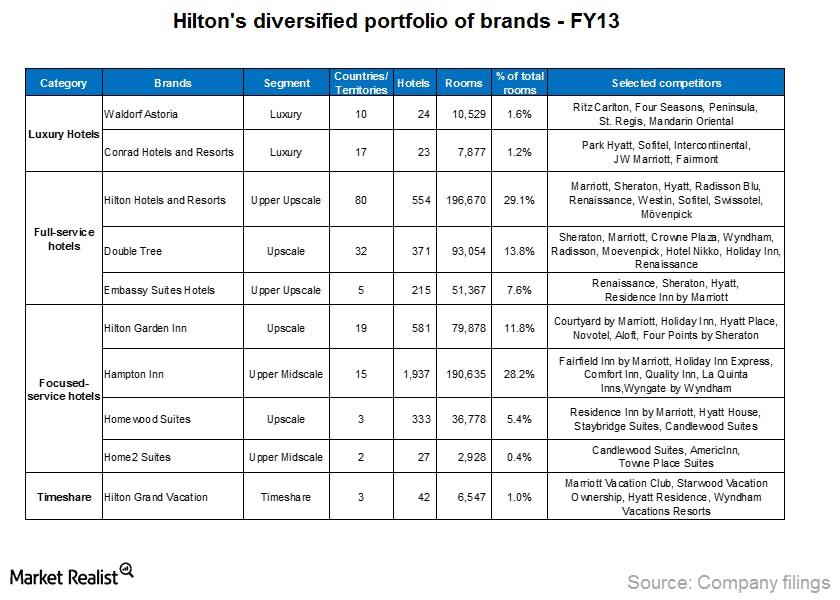Hyatt Hotels Corporation
Latest Hyatt Hotels Corporation News and Updates

Overview: Hilton Worldwide Holdings Inc.
Hilton Worldwide Holdings is one of the largest hospitality companies in the world. It was founded in 1919 by Conrad Hilton. The company started when he bought his first hotel in Texas.Consumer Why trend in fee income is an important source of revenue
Marriott increased its fee income at a ten-year compound annual growth rate (or CAGR) of 7.6% to $1,543 million in 2013—from $742 million in 2003.
Understanding Marriott International’s Valuation Multiple
In fiscal 2014, Marriott had forward EV-to-EBITDA multiple of 15.3. It was trading at 11.2 as of January 1, 2016, which was the highest among peers.
Why Did Hyatt Sell Its Vacation Ownership Segment?
Hyatt is focusing on increasing its presence to under-penetrated markets. The company believes that its presence in emerging markets such as India and China is essential for its growth.Consumer Why Marriott is slowly expanding in international markets
Marriott has been expanding its presence in the international market. It added new brands in Europe, Asia Pacific, and the Middle East and African regions.Must-know: Marriott International Inc.
Marriott International’s headquarters are in Bethesda, Maryland. The company was founded in 1927 by J. Willard and Alice S. Marriott.Consumer Hilton’s diversified portfolio with 11 world-class brands
Hilton’s goal is to serve any customer, anywhere in the world, for any lodging need that they have. The company has a portfolio of 11 world-class brands. Hilton’s portfolio allows it to accomplish this goal.Hilton’s hotel room composition by brand and chain scale
Hotel companies, like Hilton, expand their operations based on the demand for accommodations by location. They also expand based on customer preference for the level of service offerings.
Marriott’s Revenue Is Now Expected to Go This Way in 2017
In 2Q17, Marriott’s revenues grew 49% YoY to $5.8 billion, compared with $3.9 billion in 2Q16, due to higher fee revenues and RevPAR and room growth.
How Hyatt’s Valuation Compares
Current valuation Hyatt (H) currently trades at a forward EV-to-EBITDA multiple of 15.1x. Hyatt’s valuation is significantly higher than its average valuation since January 2010 of 13.0x. Peer comparison Hyatt’s valuation is among the highest in its peer group. Marriott International (MAR) has a multiple of 15.3x, Hilton Worldwide Holdings (HLT) is trading at a […]
Average Daily Rate Will Drive US Hotel Industry Growth
The average daily rate (or ADR) measures the average room price paid in the market. In 1Q17, the ADR rose 2.5% year-over-year (or YoY) to $124.27.
US Hotel Industry Supply to Outpace Demand in 2017
The US hotel industry saw its largest revenue fall of 14% year-over-year (or YoY) in 2009. Since then, recovery has been steep.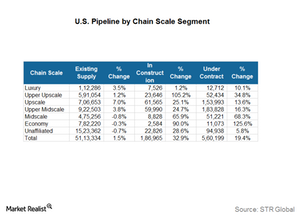
Why Hotel Investors Should Follow Construction Pipeline Data
According to STR Global’s US Construction Pipeline Report for January 2017, rooms under contract rose 16.1% to reach 576,000 rooms in 4,763 hotel properties.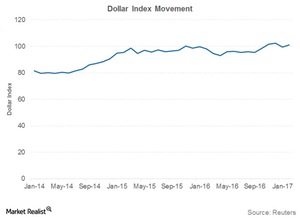
What a Strong US Dollar Means for the US Hotel Industry
The strength of the US dollar measured against currencies that are widely used in international trade is measured by the Trade Weighted Dollar Index.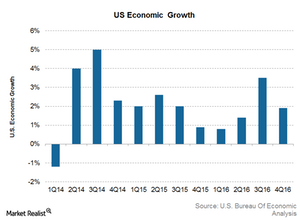
Why Economic Growth Is Important for the US Hotel Industry
A booming economy allows people to spend money on discretionary items such as air travel, so hotel revenues are higher during economic growth and lower during economic contraction.
What You Need to Know about the US Hotel Industry Performance
The hotel industry is largely driven by the growth of the general economy, which instills spending confidence in both businesses and households.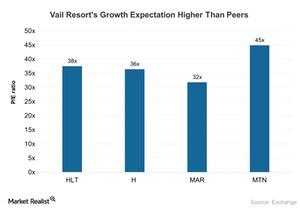
Vail Resorts: Exceptional Takes Time, According to Baron
Baron Capital began investing in Vail Resorts in 1997, and it owns a ~15%–20% stake in the company. According to Ron Baron, this investment has returned ~50%–75%.
What Are Investors Willing to Pay for Marriott International?
Marriott (MAR) currently trades at a forward EV-to-EBITDA multiple of 15.8x. Its valuation has been significantly higher than its average valuation.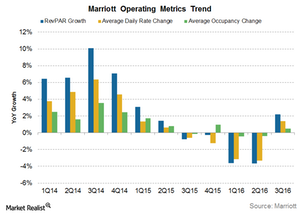
What Do Marriott’s Key Metrics Suggest ahead of 4Q16 Results?
For 3Q16, Marriott and Starwood Hotels & Resorts together added 17,600 rooms, taking the total to 4,554 properties and 777,000 timeshare resorts.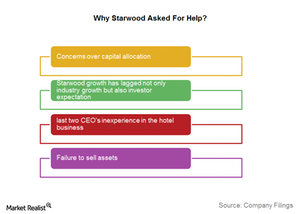
Why Did Starwood Sell Itself?
The last two years have been marked by turmoil for Starwood Hotels (HOT). Starwood’s properties include brands like the Sheraton, Westin, St. Regis, and W hotels.
Understanding the Hotel Industry Valuation Multiple
The forward EV-to-EBITDA multiple for the hotel industry currently stands at 9. It has declined from 13.1, which was recorded at the beginning of 2015.
Marriott International’s Expansion in the Franchise Model Is Bearing Fruit
Marriott’s operating margin increased from 5.9% in 2010 to 8.4% in 2014. Its operating income grew from $695 million in 2010 to $1,159 million in 2014.
Understanding Cost Reimbursements as a Key Part of Marriott International’s Revenues
Cost reimbursements make up a major component of Marriott’s revenues and mostly consist of salaries paid to employees working in Marriott-managed hotels.
Why Marriott Relies Heavily on Its Franchise Model for Growth
Marriott now focuses on capital-light segments like franchised properties. Its fee incomes rose from $1.2 billion to $1.7 billion between 2006–2014.
Marriott International’s Business Model by Service Category: Key Investor Takeaways
At the end of 2014, Marriott had around 2,882 franchised hotel properties, with 388,670 rooms under the franchise model.
Investor Essentials: Understanding Hyatt’s Valuation Multiple
Hyatt’s EV/EBITDA has moved in line with the median valuation multiple of its peers. Hyatt, with rare exceptions, has always traded at a discount to the median valuation multiple of its peers.
Why Hyatt Has High Liquid Assets Compared to Its Peers
As of December 31, 2014, Hyatt’s cash, cash equivalents, and marketable securities as a percentage of total assets is one of the highest among its peers, at 10%.
Asset Utilization by Hyatt Hotels
Hyatt had the lowest return on assets (or ROA) ratio among its peers at 4.6% for fiscal 2014 due to lower profits generated from its assets.
Profitability Margins Grew for Hyatt Hotels
Operating margins for Hyatt Hotel (H) increased from 1.4% in 2010 to 6.3% in 2014. The growth in margins was largely driven by steady growth in revenue and declining expenses from the owned and leased hotels segment.
Why Hyatt Has the Highest ADR and Occupancy Rate Among Its Peers
At 76.2%, Hyatt Hotels (H) had one of the highest occupancy rates among its peers for its owned and leased hotels in 2014.
How Does Hyatt Make Money from Its Hotels?
Hyatt (H) operates its hotels and other business segments under three models: franchise, management, and ownership models.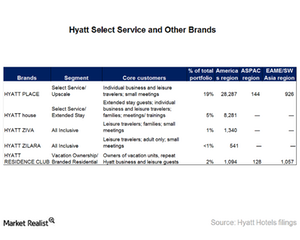
Introduction to Hyatt’s Select Service Brands and Other Brands
Hotels that offer accommodation with limited services and amenities are called select service hotels. Hyatt (H) operates about 37,500 rooms and two brands under this segment.
An Overview of Hyatt Hotels’ Competition
Some of Hyatt’s competitors—Hilton (HLT), Marriott (MAR), Wyndham (WYN), and Starwood (HOT)—compete in all the segments: Hotels and Resorts, Residential Units, and Vacation Ownership Units.
The Investor’s Introduction to Hyatt Hotels
A global hospitality group, Hyatt (H) operates industry-leading brands such as Park Hyatt, Andaz, Hyatt, Grand Hyatt, and Hyatt Regency. As of December 31, 2014, the company operated 587 properties with more than 155,000 rooms.
A Rundown of Wyndham Worldwide’s Wyndham Hotel Group Segment
Wyndham Hotel Group provides services under a franchise model but also offers professional oversight and operations support under a management model.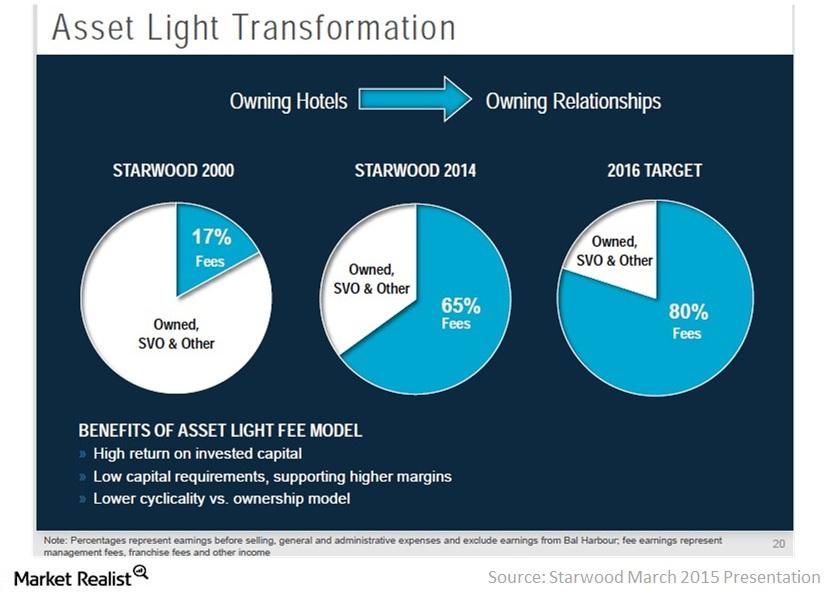
Analyzing Starwood’s Asset-Light Strategy
In 2006, Starwood’s management embarked on an asset-light strategy. It decided to sell a significant portion of Starwood’s owned hotel portfolio.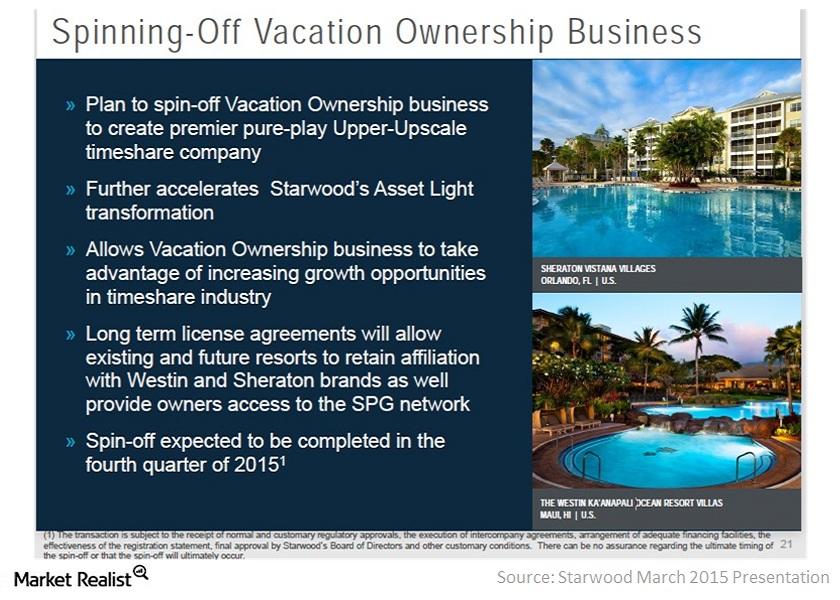
Starwood’s Vacation Ownership Business Spin-Off
On February 10, 2015, Starwood Hotels and Resorts announced plans to spin off its vacation ownership business into a separate publicly traded company.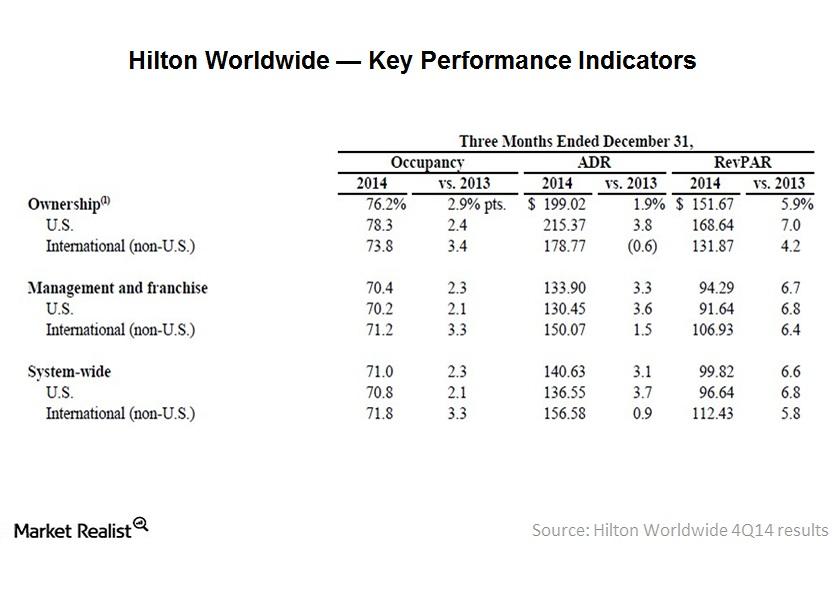
Hilton’s revenue was driven by occupancy and room pricing
Hilton Worldwide (HLT) generates revenue from its hotel operations. Hilton’s system-wide occupancy increased 2.3% YoY to 71% in 4Q14.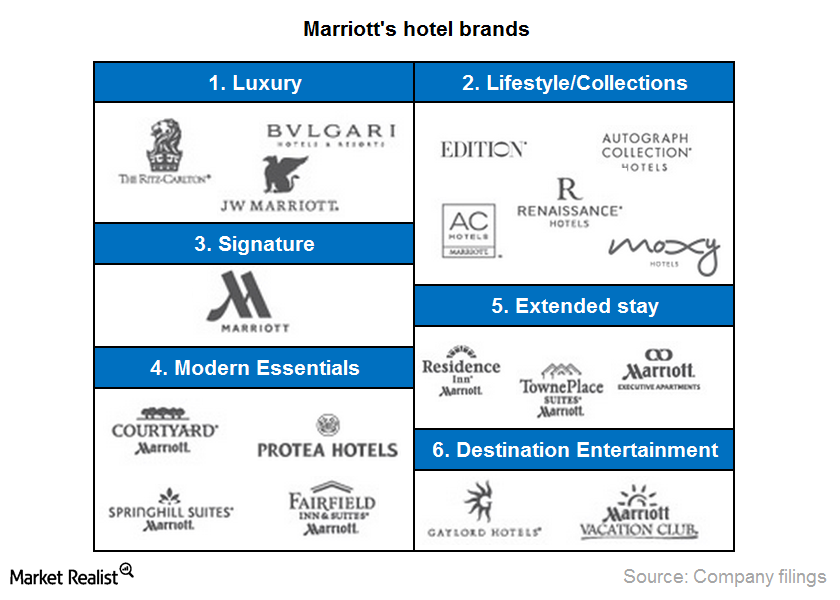
Why it’s important to understand Marriott’s brands
Marriott has a diverse portfolio of 18 brands. It describes the brands as “individually distinct and collectively powerful.”
Why the EV/EBITDAR multiple is best for valuing hotel companies
The EV to EBITDAR multiple is used in businesses where there’s significant rental and lease expenses—hotels and airlines. We’ve used this to analyze Marriott’s valuation.Consumer Understanding Hilton’s operating cost
Hilton has operating expenses related to its owned and leased hotels and timeshare properties. This is separate from depreciation and amortization expenses.Consumer Key revenue drivers for the hotel industry
RevPAR is calculated by dividing hotel room revenue by the total available room nights. It’s used in the hotel industry to measure the company’s ability to generate greater revenue from each room.Consumer Must-know: Hilton gets revenue from its timeshare segment
Timesharing—also known as vacation ownership—is a method of getting the right to use a vacation property like a hotel or a resort. The buyer owns “timeshare interests” or intervals.Consumer A breakdown of Hilton’s revenue by segments
Timeshare revenue accounted for ~18% of total revenue from segments. The company generates revenue by marketing and selling timeshare interests and managing resort operations.Consumer Why Hilton expanded its presence in the international market
Hilton’s hotels, resorts, and timeshare properties are spread across 91 countries and territories. On December 31, 2013, Hilton’s portfolio consisted of 678,630 rooms.Consumer Hilton’s market share in the domestic and international market
Hilton’s growth plans are measured by the number of rooms under construction. Its growth plans rank first in the industry in all its markets—domestic and international.Consumer Why InterContinental Hotels’ “asset-light” strategy drives growth
The company said on its website that its “business model is focused on franchising and managing hotels, rather than owning them, enabling us to grow at an accelerated pace with limited capital investment—we call this ‘asset light.’

